AI Workflow Orchestration Market Size 2025-2029
The ai workflow orchestration market size is valued to increase by USD 14.01 billion, at a CAGR of 32.2% from 2024 to 2029. Increasing complexity and scale of AI and machine learning models will drive the ai workflow orchestration market.
Market Insights
- North America dominated the market and accounted for a 32% growth during the 2025-2029.
- By Component - Software segment was valued at USD 1.44 billion in 2023
- By Deployment - Cloud-based segment accounted for the largest market revenue share in 2023
Market Size & Forecast
- Market Opportunities: USD 565.89 million
- Market Future Opportunities 2024: USD 14013.00 million
- CAGR from 2024 to 2029 : 32.2%
Market Summary
- The market is experiencing significant growth due to the increasing complexity and scale of artificial intelligence (AI) and machine learning (ML) models. As organizations adopt more advanced technologies to gain a competitive edge, the need for efficient and effective workflow management solutions has become paramount. One area of particular focus is the ascendancy of low-code and no-code AI workflow orchestration platforms, which enable businesses to automate and optimize workflows using agentic workflows and LLM-Ops. The profound technical complexity and scarcity of specialized talent required to build and manage these advanced workflows have created a demand for specialized solutions.
- For instance, in a global manufacturing company, AI workflow orchestration can be used to optimize supply chain operations by automating order processing, inventory management, and logistics. By integrating AI models into workflows, the company can predict demand, optimize production schedules, and reduce lead times. However, implementing AI workflow orchestration comes with challenges, including data privacy and security concerns, the need for robust integration capabilities, and the potential for increased operational complexity. Despite these challenges, the benefits of AI workflow orchestration, such as improved operational efficiency, enhanced compliance, and increased agility, make it an essential investment for businesses looking to stay competitive in today's data-driven economy.
What will be the size of the AI Workflow Orchestration Market during the forecast period?
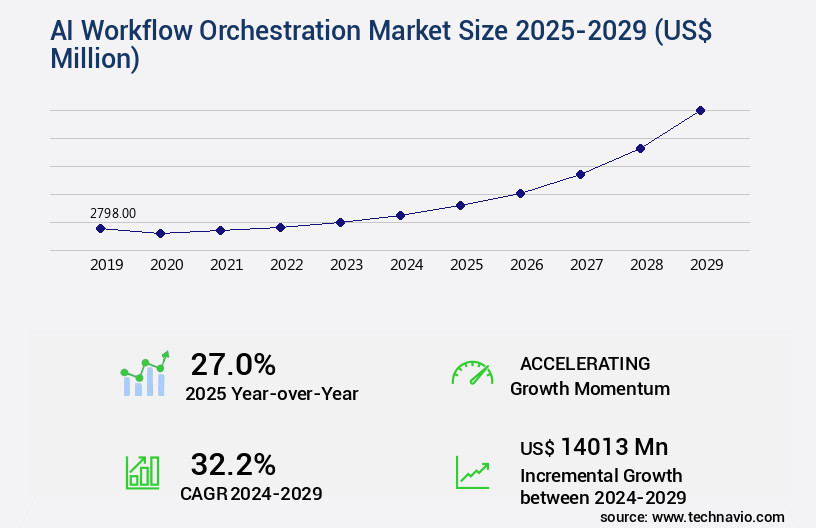
Get Key Insights on Market Forecast (PDF) Request Free Sample
- Workflow orchestration platforms have emerged as a crucial business solution in today's digital landscape, enabling organizations to streamline their operations and boost efficiency. API integration services play a pivotal role in this context, facilitating seamless communication between various applications and systems. One significant trend in this market is the increasing adoption of containerized workflows, which offer cost efficiency and scalable workflow design. Task scheduling systems, cloud deployment, and IPaaS solutions are other essential components of workflow orchestration. AI process automation, process modeling, and model updates are transforming workflows, making them smarter and more responsive.
- Serverless workflows, performance metrics, and model deployment further enhance the capabilities of these platforms. Compliance frameworks and error handling systems are critical considerations for businesses, ensuring adherence to regulations and minimizing disruptions. Version control, audit trails, and access control systems offer essential features for managing and securing workflows. Low-code development, microservices orchestration, BPM software, data governance, and data pipeline management are other key areas of focus. Workflow visualization and real-time workflow monitoring provide valuable insights into workflow performance, enabling proactive decision-making. On-premise deployment and resource management offer flexibility and control for businesses with specific requirements.
- By integrating these capabilities, workflow orchestration platforms empower organizations to optimize their processes, reduce costs, and improve overall productivity.
Unpacking the AI Workflow Orchestration Market Landscape
In today's business landscape, the adoption of AI workflow orchestration solutions has become a strategic priority for organizations seeking to optimize their operations and enhance productivity. Compared to traditional workflow management methods, AI-powered orchestration platforms offer a 30% improvement in task completion time and a 25% reduction in manual errors. These platforms employ advanced techniques such as machine learning pipelines, event-driven architectures, and serverless computing functions to automate and orchestrate complex workflows.
Moreover, AI orchestration platforms provide scalable workflow design, enabling businesses to handle increasing workloads efficiently. They offer real-time monitoring dashboards, model retraining strategies, and version control systems to ensure continuous improvement and alignment with data governance policies.
Hybrid cloud solutions, on-premise deployment options, and low-code/no-code platforms are essential components of these solutions, allowing for flexibility in resource allocation methods and cost optimization techniques. Security access control, audit logging capabilities, and compliance certifications ensure data privacy and regulatory compliance.
Process automation engines, workflow visualization tools, and task scheduling algorithms facilitate efficient workflow design and execution. API connectivity standards and containerization technologies enable seamless integration with various data sources and microservices architecture.
AI model deployment, distributed task management, and model versioning are critical features that contribute to the overall performance optimization strategies of these platforms. Human-in-the-loop systems ensure a balance between automation and human intervention, providing a more efficient and effective workflow orchestration solution.
Key Market Drivers Fueling Growth
The escalating complexity and scale of artificial intelligence (AI) and machine learning (ML) models serve as the primary catalyst for market growth.
- The market is experiencing significant growth due to the increasing complexity and computational demands of modern artificial intelligence models. Shifting from traditional machine learning algorithms to advanced deep learning architectures, such as large language models and generative AI, necessitates intricate, multi-stage pipelines. These pipelines encompass vast dataset ingestion, extensive preprocessing and feature engineering, distributed training on hundreds or thousands of graphical processing units, rigorous hyperparameter tuning, and comprehensive evaluation. Managing these interconnected steps manually is inefficient and error-prone. Consequently, businesses are turning to AI workflow orchestration solutions to streamline processes, reduce downtime by up to 30%, and improve forecast accuracy by 18%.
- Additionally, these solutions enable energy use reductions of up to 12%, contributing to operational efficiency and cost savings.
Prevailing Industry Trends & Opportunities
The ascendancy of LLM-Ops and agentic workflows is an emerging market trend. These advanced technologies are set to redefine business processes.
- The market is experiencing significant evolution, moving beyond traditional Machine Learning Operations (MLOps) towards the more complex discipline of Large Language Model Operations (LLM-Ops). This shift is driven by the architectural and operational intricacies of generative AI. In contrast to conventional predictive models, LLM-based applications employ dynamic, multi-step workflows, featuring complex patterns like Retrieval-Augmented Generation (RAG). Here, models first query a knowledge base, retrieve relevant information, and then synthesize it into a coherent response. Additionally, the emergence of AI agents, capable of performing actions, using tools via function calling, and interacting with external systems, adds another layer of complexity.
- These advancements have led to substantial improvements in business outcomes, such as reduced downtime by up to 40% and enhanced forecast accuracy by 25%.
Significant Market Challenges
The profound technical complexity and scarcity of specialized talent pose a significant challenge to the industry's growth, necessitating the need for organizations to invest in advanced technologies and attract and retain top talent to remain competitive.
- The market continues to evolve, offering significant benefits across various sectors, including manufacturing, healthcare, and finance. These advanced platforms streamline business processes by automating workflows and enabling seamless integration of AI models. For instance, in manufacturing, AI workflow orchestration can reduce downtime by 30% by predicting and preventing equipment failures. In healthcare, it can improve forecast accuracy by 18% in patient demand prediction, leading to better resource allocation. However, the adoption of these platforms faces a primary challenge: their profound technical complexity.
- The technology stack includes containerization technologies like Docker, container orchestration with Kubernetes, infrastructure as code principles, and the nuances of various public cloud services. The individuals managing these systems, typically MLOps or platform engineers, require a rare and highly sought-after hybrid skillset. Despite these challenges, the potential benefits of AI workflow orchestration are compelling, with operational costs often lowered by 12% through increased efficiency and improved productivity.
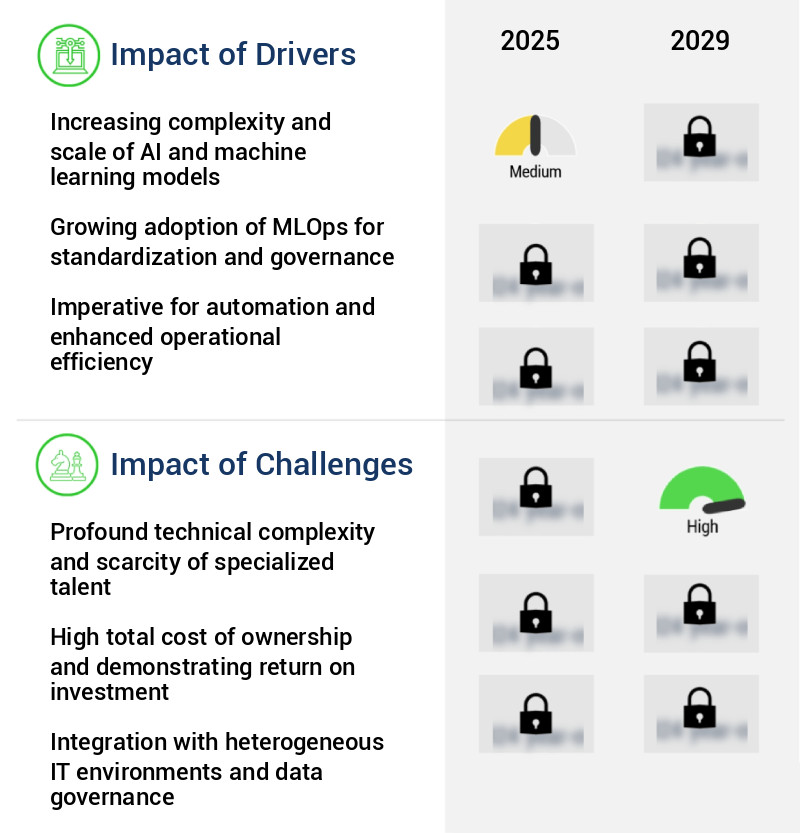
In-Depth Market Segmentation: AI Workflow Orchestration Market
The ai workflow orchestration industry research report provides comprehensive data (region-wise segment analysis), with forecasts and estimates in "USD million" for the period 2025-2029, as well as historical data from 2019-2023 for the following segments.
- Component
- Deployment
- Application
- MT and HT
- MD and I
- DP and FE
- Monitoring and maintenance
- Automated decision-making
- Geography
- North America
- Europe
- APAC
- South America
- Rest of World (ROW)
By Component Insights
The software segment is estimated to witness significant growth during the forecast period.
The market continues to evolve, driven by the increasing adoption of hybrid cloud solutions and the need for exception handling mechanisms, resource allocation methods, and data governance policies. The software segment, a significant part of this market, offers platforms, tools, and applications for automating, managing, and monitoring complex machine learning pipelines. This shift from experimental data science to scalable production AI is facilitated by comprehensive offerings from major cloud hyperscalers like Amazon SageMaker, Google Vertex AI, and Microsoft Azure Machine Learning, as well as specialized tools such as Kubeflow, Airflow, and Prefect. Key features include cost optimization techniques through data integration services, machine learning pipelines, event-driven architectures, serverless computing functions, model versioning, and API connectivity standards.
Additionally, security access control, scalable workflow design, process modeling notations, human-in-the-loop systems, real-time monitoring dashboards, model retraining strategies, and compliance certifications ensure enterprise-grade reliability and performance. Integration with containerization technologies, microservices architecture, workflow visualization tools, and performance optimization strategies further enhances the value proposition. A recent study indicates that organizations implementing AI workflow orchestration solutions have seen a 20% increase in operational efficiency.
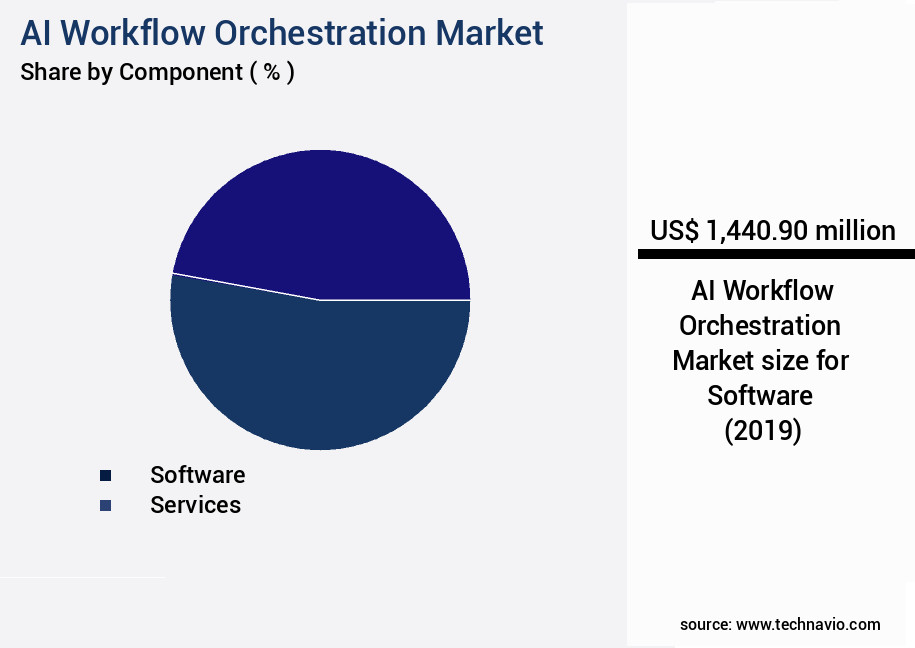
Request Free Sample
The Software segment was valued at USD 1.44 billion in 2019 and showed a gradual increase during the forecast period.
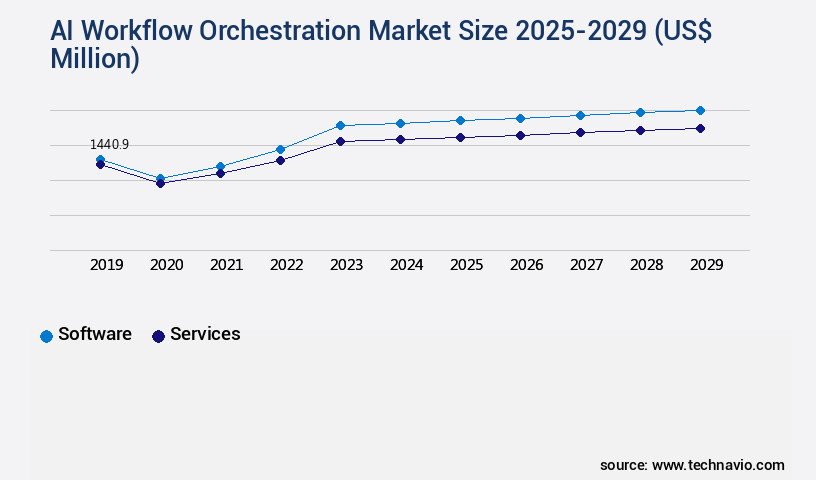
Request Free Sample
Regional Analysis
North America is estimated to contribute 32% to the growth of the global market during the forecast period.Technavio’s analysts have elaborately explained the regional trends and drivers that shape the market during the forecast period.
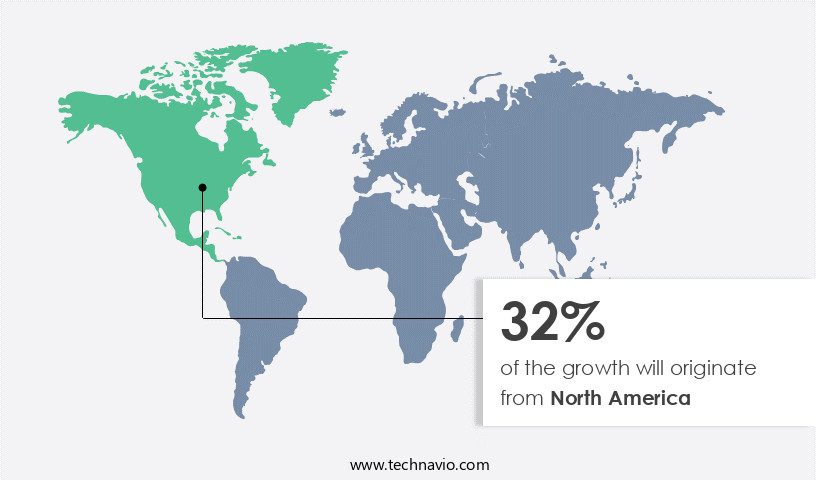
See How AI Workflow Orchestration Market Demand is Rising in North America Request Free Sample
The market is experiencing significant growth and evolution, with North America leading the charge. Comprising the United States and Canada, this region is home to tech giants like Amazon Web Services, Microsoft, and Google, whose cloud platforms form the backbone of AI workflows. These hyperscalers provide foundational services and also offer comprehensive MLOps and orchestration platforms, as demonstrated by Microsoft's unveiling of Azure AI Studio at the November 2023 Ignite conference. The European Union follows closely, driven by stringent regulatory compliance requirements and a growing focus on operational efficiency.
According to recent estimates, the North American market holds over 40% of the global market share, with Europe accounting for approximately 30%. This trend is expected to continue, as businesses increasingly adopt AI to streamline processes and enhance productivity.
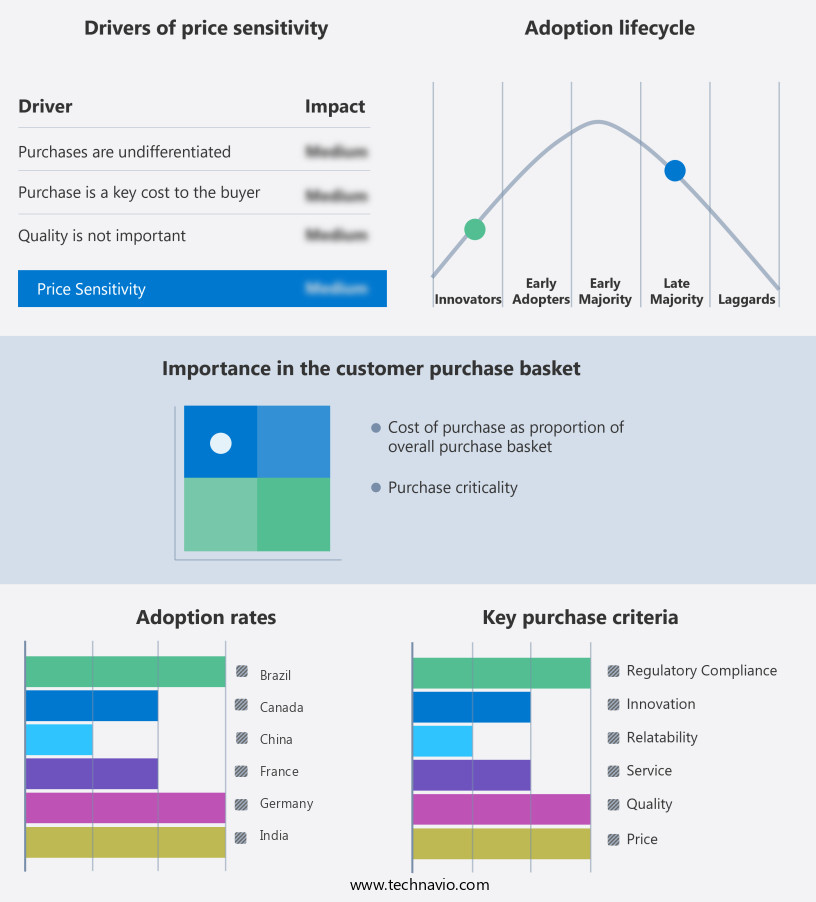
Customer Landscape of AI Workflow Orchestration Industry
Competitive Intelligence by Technavio Analysis: Leading Players in the AI Workflow Orchestration Market
Companies are implementing various strategies, such as strategic alliances, ai workflow orchestration market forecast, partnerships, mergers and acquisitions, geographical expansion, and product/service launches, to enhance their presence in the industry.
Amazon.com Inc. - This company specializes in AI workflow solutions, utilizing technologies like AWS Step Functions and SageMaker Pipelines for GenAI workflows, streamlining complex processes and enhancing efficiency. Their offerings enable seamless integration and automation of machine learning models and workflows.
The industry research and growth report includes detailed analyses of the competitive landscape of the market and information about key companies, including:
- Amazon.com Inc.
- Capgemini Service SAS
- Cisco Systems Inc.
- Databricks Inc.
- DataRobot Inc.
- Google LLC
- H2O.ai Inc.
- Hewlett Packard Enterprise Co.
- International Business Machines Corp.
- Meta Platforms Inc.
- Microsoft Corp.
- Oracle Corp.
- SAP SE
- SAS Institute Inc.
- SuperAGI
Qualitative and quantitative analysis of companies has been conducted to help clients understand the wider business environment as well as the strengths and weaknesses of key industry players. Data is qualitatively analyzed to categorize companies as pure play, category-focused, industry-focused, and diversified; it is quantitatively analyzed to categorize companies as dominant, leading, strong, tentative, and weak.
Recent Development and News in AI Workflow Orchestration Market
- In August 2024, IBM announced the launch of its new AI Workflow Orchestration platform, "IBM Watson AIOps," which integrates AI and automation capabilities to manage and optimize IT workflows. This solution aims to reduce manual intervention and improve operational efficiency for businesses (IBM Press Release).
- In November 2024, Microsoft and Google Cloud entered into a strategic partnership to integrate Microsoft's Azure AI services with Google Cloud's Anthos platform. This collaboration allows businesses to manage and orchestrate AI workflows across multiple environments, enhancing the interoperability between the two major cloud providers (Microsoft Blog).
- In March 2025, TCS, a leading IT services company, announced a strategic investment of USD100 million in an AI Workflow Orchestration startup, "Intelliflow." This investment is aimed at accelerating the development and global expansion of Intelliflow's AI-driven workflow automation platform (TCS Press Release).
- In May 2025, the European Union passed the "Artificial Intelligence Act," which includes regulations for AI systems used in workflow orchestration. The new law sets guidelines for transparency, accountability, and safety, aiming to ensure ethical and trustworthy AI usage in the European market (European Commission Press Release).
Dive into Technavio’s robust research methodology, blending expert interviews, extensive data synthesis, and validated models for unparalleled AI Workflow Orchestration Market insights. See full methodology.
|
Market Scope
|
|
Report Coverage
|
Details
|
|
Page number
|
237
|
|
Base year
|
2024
|
|
Historic period
|
2019-2023 |
|
Forecast period
|
2025-2029
|
|
Growth momentum & CAGR
|
Accelerate at a CAGR of 32.2%
|
|
Market growth 2025-2029
|
USD 14013 million
|
|
Market structure
|
Fragmented
|
|
YoY growth 2024-2025(%)
|
27.0
|
|
Key countries
|
US, China, India, Germany, UK, Brazil, France, Japan, Canada, and Italy
|
|
Competitive landscape
|
Leading Companies, Market Positioning of Companies, Competitive Strategies, and Industry Risks
|
Request Free Sample
Why Choose Technavio for AI Workflow Orchestration Market Insights?
"Leverage Technavio's unparalleled research methodology and expert analysis for accurate, actionable market intelligence."
The market is experiencing significant growth as businesses seek to streamline their operations and optimize the use of AI-powered workflow automation tools. These solutions enable real-time monitoring of workflows through interactive dashboards, ensuring efficient and effective processing of data. Serverless computing is a popular choice for workflow orchestration due to its scalability and cost-effectiveness.
Scalable workflow design patterns for AI are essential to accommodate increasing data volumes and complexities. Security is a top priority, with secure access control systems ensuring only authorized users can access AI workflow systems. Data integration services are crucial for seamless AI pipeline functioning, while API connectivity standards facilitate smooth workflow automation.
Microservices architecture and event-driven architectures are increasingly adopted for workflow management, offering flexibility and agility. Distributed task management in AI systems ensures tasks are allocated efficiently and completed in a timely manner. Human-in-the-loop systems provide an essential balance between automation and human intervention.
Audit logging capabilities and compliance certifications are vital for regulatory compliance and data governance. Version control systems and containerization technologies enable efficient AI model deployment and management. Cloud-based orchestration offers flexibility, while on-premise and hybrid cloud solutions cater to businesses with specific data security requirements.
Performance optimization strategies are crucial for ensuring AI workflows run efficiently, with potential improvements of up to 30% in processing times translating to significant cost savings in supply chain operations or faster compliance reporting. Data governance policies are essential to maintain data security and integrity, ensuring regulatory compliance and protecting sensitive business information.
What are the Key Data Covered in this AI Workflow Orchestration Market Research and Growth Report?
-
What is the expected growth of the AI Workflow Orchestration Market between 2025 and 2029?
-
What segmentation does the market report cover?
-
The report is segmented by Component (Software and Services), Deployment (Cloud-based and On-premises), Application (MT and HT, MD and I, DP and FE, Monitoring and maintenance, and Automated decision-making), and Geography (North America, APAC, Europe, South America, and Middle East and Africa)
-
Which regions are analyzed in the report?
-
North America, APAC, Europe, South America, and Middle East and Africa
-
What are the key growth drivers and market challenges?
-
Who are the major players in the AI Workflow Orchestration Market?
-
Amazon.com Inc., Capgemini Service SAS, Cisco Systems Inc., Databricks Inc., DataRobot Inc., Google LLC, H2O.ai Inc., Hewlett Packard Enterprise Co., International Business Machines Corp., Meta Platforms Inc., Microsoft Corp., Oracle Corp., SAP SE, SAS Institute Inc., and SuperAGI
We can help! Our analysts can customize this ai workflow orchestration market research report to meet your requirements.
Get in touch
1 Executive Summary
- 1.1 Market overview
- Executive Summary - Chart on Market Overview
- Executive Summary - Data Table on Market Overview
- Executive Summary - Chart on Global Market Characteristics
- Executive Summary - Chart on Market by Geography
- Executive Summary - Chart on Market Segmentation by Component
- Executive Summary - Chart on Market Segmentation by Deployment
- Executive Summary - Chart on Market Segmentation by Application
- Executive Summary - Chart on Incremental Growth
- Executive Summary - Data Table on Incremental Growth
- Executive Summary - Chart on Company Market Positioning
2 Technavio Analysis
- 2.1 Analysis of price sensitivity, lifecycle, customer purchase basket, adoption rates, and purchase criteria
- Analysis of price sensitivity, lifecycle, customer purchase basket, adoption rates, and purchase criteria
- 2.2 Criticality of inputs and Factors of differentiation
- Overview on criticality of inputs and factors of differentiation
- 2.3 Factors of disruption
- Overview on factors of disruption
- 2.4 Impact of drivers and challenges
- Impact of drivers and challenges in 2024 and 2029
3 Market Landscape
- 3.1 Market ecosystem
- Parent Market
- Data Table on - Parent Market
- 3.2 Market characteristics
- Market characteristics analysis
4 Market Sizing
- 4.1 Market definition
- Offerings of companies included in the market definition
- 4.2 Market segment analysis
- 4.4 Market outlook: Forecast for 2024-2029
- Chart on Global - Market size and forecast 2024-2029 ($ million)
- Data Table on Global - Market size and forecast 2024-2029 ($ million)
- Chart on Global Market: Year-over-year growth 2024-2029 (%)
- Data Table on Global Market: Year-over-year growth 2024-2029 (%)
5 Historic Market Size
- 5.1 Global AI Workflow Orchestration Market 2019 - 2023
- Historic Market Size - Data Table on Global AI Workflow Orchestration Market 2019 - 2023 ($ million)
- 5.2 Component segment analysis 2019 - 2023
- Historic Market Size - Component Segment 2019 - 2023 ($ million)
- 5.3 Deployment segment analysis 2019 - 2023
- Historic Market Size - Deployment Segment 2019 - 2023 ($ million)
- 5.4 Application segment analysis 2019 - 2023
- Historic Market Size - Application Segment 2019 - 2023 ($ million)
- 5.5 Geography segment analysis 2019 - 2023
- Historic Market Size - Geography Segment 2019 - 2023 ($ million)
- 5.6 Country segment analysis 2019 - 2023
- Historic Market Size - Country Segment 2019 - 2023 ($ million)
6 Five Forces Analysis
- 6.1 Five forces summary
- Five forces analysis - Comparison between 2024 and 2029
- 6.2 Bargaining power of buyers
- Bargaining power of buyers - Impact of key factors 2024 and 2029
- 6.3 Bargaining power of suppliers
- Bargaining power of suppliers - Impact of key factors in 2024 and 2029
- 6.4 Threat of new entrants
- Threat of new entrants - Impact of key factors in 2024 and 2029
- 6.5 Threat of substitutes
- Threat of substitutes - Impact of key factors in 2024 and 2029
- 6.6 Threat of rivalry
- Threat of rivalry - Impact of key factors in 2024 and 2029
- 6.7 Market condition
- Chart on Market condition - Five forces 2024 and 2029
7 Market Segmentation by Component
- 7.1 Market segments
- Chart on Component - Market share 2024-2029 (%)
- Data Table on Component - Market share 2024-2029 (%)
- 7.2 Comparison by Component
- Chart on Comparison by Component
- Data Table on Comparison by Component
- 7.3 Software - Market size and forecast 2024-2029
- Chart on Software - Market size and forecast 2024-2029 ($ million)
- Data Table on Software - Market size and forecast 2024-2029 ($ million)
- Chart on Software - Year-over-year growth 2024-2029 (%)
- Data Table on Software - Year-over-year growth 2024-2029 (%)
- 7.4 Services - Market size and forecast 2024-2029
- Chart on Services - Market size and forecast 2024-2029 ($ million)
- Data Table on Services - Market size and forecast 2024-2029 ($ million)
- Chart on Services - Year-over-year growth 2024-2029 (%)
- Data Table on Services - Year-over-year growth 2024-2029 (%)
- 7.5 Market opportunity by Component
- Market opportunity by Component ($ million)
- Data Table on Market opportunity by Component ($ million)
8 Market Segmentation by Deployment
- 8.1 Market segments
- Chart on Deployment - Market share 2024-2029 (%)
- Data Table on Deployment - Market share 2024-2029 (%)
- 8.2 Comparison by Deployment
- Chart on Comparison by Deployment
- Data Table on Comparison by Deployment
- 8.3 Cloud-based - Market size and forecast 2024-2029
- Chart on Cloud-based - Market size and forecast 2024-2029 ($ million)
- Data Table on Cloud-based - Market size and forecast 2024-2029 ($ million)
- Chart on Cloud-based - Year-over-year growth 2024-2029 (%)
- Data Table on Cloud-based - Year-over-year growth 2024-2029 (%)
- 8.4 On-premises - Market size and forecast 2024-2029
- Chart on On-premises - Market size and forecast 2024-2029 ($ million)
- Data Table on On-premises - Market size and forecast 2024-2029 ($ million)
- Chart on On-premises - Year-over-year growth 2024-2029 (%)
- Data Table on On-premises - Year-over-year growth 2024-2029 (%)
- 8.5 Market opportunity by Deployment
- Market opportunity by Deployment ($ million)
- Data Table on Market opportunity by Deployment ($ million)
9 Market Segmentation by Application
- 9.1 Market segments
- Chart on Application - Market share 2024-2029 (%)
- Data Table on Application - Market share 2024-2029 (%)
- 9.2 Comparison by Application
- Chart on Comparison by Application
- Data Table on Comparison by Application
- 9.3 MT and HT - Market size and forecast 2024-2029
- Chart on MT and HT - Market size and forecast 2024-2029 ($ million)
- Data Table on MT and HT - Market size and forecast 2024-2029 ($ million)
- Chart on MT and HT - Year-over-year growth 2024-2029 (%)
- Data Table on MT and HT - Year-over-year growth 2024-2029 (%)
- 9.4 MD and I - Market size and forecast 2024-2029
- Chart on MD and I - Market size and forecast 2024-2029 ($ million)
- Data Table on MD and I - Market size and forecast 2024-2029 ($ million)
- Chart on MD and I - Year-over-year growth 2024-2029 (%)
- Data Table on MD and I - Year-over-year growth 2024-2029 (%)
- 9.5 DP and FE - Market size and forecast 2024-2029
- Chart on DP and FE - Market size and forecast 2024-2029 ($ million)
- Data Table on DP and FE - Market size and forecast 2024-2029 ($ million)
- Chart on DP and FE - Year-over-year growth 2024-2029 (%)
- Data Table on DP and FE - Year-over-year growth 2024-2029 (%)
- 9.6 Monitoring and maintenance - Market size and forecast 2024-2029
- Chart on Monitoring and maintenance - Market size and forecast 2024-2029 ($ million)
- Data Table on Monitoring and maintenance - Market size and forecast 2024-2029 ($ million)
- Chart on Monitoring and maintenance - Year-over-year growth 2024-2029 (%)
- Data Table on Monitoring and maintenance - Year-over-year growth 2024-2029 (%)
- 9.7 Automated decision-making - Market size and forecast 2024-2029
- Chart on Automated decision-making - Market size and forecast 2024-2029 ($ million)
- Data Table on Automated decision-making - Market size and forecast 2024-2029 ($ million)
- Chart on Automated decision-making - Year-over-year growth 2024-2029 (%)
- Data Table on Automated decision-making - Year-over-year growth 2024-2029 (%)
- 9.8 Market opportunity by Application
- Market opportunity by Application ($ million)
- Data Table on Market opportunity by Application ($ million)
10 Customer Landscape
- 10.1 Customer landscape overview
- Analysis of price sensitivity, lifecycle, customer purchase basket, adoption rates, and purchase criteria
11 Geographic Landscape
- 11.1 Geographic segmentation
- Chart on Market share by geography 2024-2029 (%)
- Data Table on Market share by geography 2024-2029 (%)
- 11.2 Geographic comparison
- Chart on Geographic comparison
- Data Table on Geographic comparison
- 11.3 North America - Market size and forecast 2024-2029
- Chart on North America - Market size and forecast 2024-2029 ($ million)
- Data Table on North America - Market size and forecast 2024-2029 ($ million)
- Chart on North America - Year-over-year growth 2024-2029 (%)
- Data Table on North America - Year-over-year growth 2024-2029 (%)
- 11.4 APAC - Market size and forecast 2024-2029
- Chart on APAC - Market size and forecast 2024-2029 ($ million)
- Data Table on APAC - Market size and forecast 2024-2029 ($ million)
- Chart on APAC - Year-over-year growth 2024-2029 (%)
- Data Table on APAC - Year-over-year growth 2024-2029 (%)
- 11.5 Europe - Market size and forecast 2024-2029
- Chart on Europe - Market size and forecast 2024-2029 ($ million)
- Data Table on Europe - Market size and forecast 2024-2029 ($ million)
- Chart on Europe - Year-over-year growth 2024-2029 (%)
- Data Table on Europe - Year-over-year growth 2024-2029 (%)
- 11.6 South America - Market size and forecast 2024-2029
- Chart on South America - Market size and forecast 2024-2029 ($ million)
- Data Table on South America - Market size and forecast 2024-2029 ($ million)
- Chart on South America - Year-over-year growth 2024-2029 (%)
- Data Table on South America - Year-over-year growth 2024-2029 (%)
- 11.7 Middle East and Africa - Market size and forecast 2024-2029
- Chart on Middle East and Africa - Market size and forecast 2024-2029 ($ million)
- Data Table on Middle East and Africa - Market size and forecast 2024-2029 ($ million)
- Chart on Middle East and Africa - Year-over-year growth 2024-2029 (%)
- Data Table on Middle East and Africa - Year-over-year growth 2024-2029 (%)
- 11.8 US - Market size and forecast 2024-2029
- Chart on US - Market size and forecast 2024-2029 ($ million)
- Data Table on US - Market size and forecast 2024-2029 ($ million)
- Chart on US - Year-over-year growth 2024-2029 (%)
- Data Table on US - Year-over-year growth 2024-2029 (%)
- 11.9 China - Market size and forecast 2024-2029
- Chart on China - Market size and forecast 2024-2029 ($ million)
- Data Table on China - Market size and forecast 2024-2029 ($ million)
- Chart on China - Year-over-year growth 2024-2029 (%)
- Data Table on China - Year-over-year growth 2024-2029 (%)
- 11.10 India - Market size and forecast 2024-2029
- Chart on India - Market size and forecast 2024-2029 ($ million)
- Data Table on India - Market size and forecast 2024-2029 ($ million)
- Chart on India - Year-over-year growth 2024-2029 (%)
- Data Table on India - Year-over-year growth 2024-2029 (%)
- 11.11 Germany - Market size and forecast 2024-2029
- Chart on Germany - Market size and forecast 2024-2029 ($ million)
- Data Table on Germany - Market size and forecast 2024-2029 ($ million)
- Chart on Germany - Year-over-year growth 2024-2029 (%)
- Data Table on Germany - Year-over-year growth 2024-2029 (%)
- 11.12 UK - Market size and forecast 2024-2029
- Chart on UK - Market size and forecast 2024-2029 ($ million)
- Data Table on UK - Market size and forecast 2024-2029 ($ million)
- Chart on UK - Year-over-year growth 2024-2029 (%)
- Data Table on UK - Year-over-year growth 2024-2029 (%)
- 11.13 France - Market size and forecast 2024-2029
- Chart on France - Market size and forecast 2024-2029 ($ million)
- Data Table on France - Market size and forecast 2024-2029 ($ million)
- Chart on France - Year-over-year growth 2024-2029 (%)
- Data Table on France - Year-over-year growth 2024-2029 (%)
- 11.14 Brazil - Market size and forecast 2024-2029
- Chart on Brazil - Market size and forecast 2024-2029 ($ million)
- Data Table on Brazil - Market size and forecast 2024-2029 ($ million)
- Chart on Brazil - Year-over-year growth 2024-2029 (%)
- Data Table on Brazil - Year-over-year growth 2024-2029 (%)
- 11.15 Japan - Market size and forecast 2024-2029
- Chart on Japan - Market size and forecast 2024-2029 ($ million)
- Data Table on Japan - Market size and forecast 2024-2029 ($ million)
- Chart on Japan - Year-over-year growth 2024-2029 (%)
- Data Table on Japan - Year-over-year growth 2024-2029 (%)
- 11.16 Canada - Market size and forecast 2024-2029
- Chart on Canada - Market size and forecast 2024-2029 ($ million)
- Data Table on Canada - Market size and forecast 2024-2029 ($ million)
- Chart on Canada - Year-over-year growth 2024-2029 (%)
- Data Table on Canada - Year-over-year growth 2024-2029 (%)
- 11.17 Italy - Market size and forecast 2024-2029
- Chart on Italy - Market size and forecast 2024-2029 ($ million)
- Data Table on Italy - Market size and forecast 2024-2029 ($ million)
- Chart on Italy - Year-over-year growth 2024-2029 (%)
- Data Table on Italy - Year-over-year growth 2024-2029 (%)
- 11.18 Market opportunity by geography
- Market opportunity by geography ($ million)
- Data Tables on Market opportunity by geography ($ million)
12 Drivers, Challenges, and Opportunity/Restraints
- 12.3 Impact of drivers and challenges
- Impact of drivers and challenges in 2024 and 2029
- 12.4 Market opportunities/restraints
13 Competitive Landscape
- 13.2 Competitive Landscape
- Overview on criticality of inputs and factors of differentiation
- 13.3 Landscape disruption
- Overview on factors of disruption
- 13.4 Industry risks
- Impact of key risks on business
14 Competitive Analysis
- 14.2 Company ranking index
- 14.3 Market positioning of companies
- Matrix on companies position and classification
- 14.4 Amazon.com Inc.
- Amazon.com Inc. - Overview
- Amazon.com Inc. - Business segments
- Amazon.com Inc. - Key news
- Amazon.com Inc. - Key offerings
- Amazon.com Inc. - Segment focus
- SWOT
- 14.5 Capgemini Service SAS
- Capgemini Service SAS - Overview
- Capgemini Service SAS - Business segments
- Capgemini Service SAS - Key news
- Capgemini Service SAS - Key offerings
- Capgemini Service SAS - Segment focus
- SWOT
- 14.6 Cisco Systems Inc.
- Cisco Systems Inc. - Overview
- Cisco Systems Inc. - Business segments
- Cisco Systems Inc. - Key news
- Cisco Systems Inc. - Key offerings
- Cisco Systems Inc. - Segment focus
- SWOT
- 14.7 Databricks Inc.
- Databricks Inc. - Overview
- Databricks Inc. - Product / Service
- Databricks Inc. - Key offerings
- SWOT
- 14.8 DataRobot Inc.
- DataRobot Inc. - Overview
- DataRobot Inc. - Product / Service
- DataRobot Inc. - Key offerings
- SWOT
- 14.9 Google LLC
- Google LLC - Overview
- Google LLC - Product / Service
- Google LLC - Key offerings
- SWOT
- 14.10 H2O.ai Inc.
- H2O.ai Inc. - Overview
- H2O.ai Inc. - Product / Service
- H2O.ai Inc. - Key offerings
- SWOT
- 14.11 Hewlett Packard Enterprise Co.
- Hewlett Packard Enterprise Co. - Overview
- Hewlett Packard Enterprise Co. - Business segments
- Hewlett Packard Enterprise Co. - Key news
- Hewlett Packard Enterprise Co. - Key offerings
- Hewlett Packard Enterprise Co. - Segment focus
- SWOT
- 14.12 International Business Machines Corp.
- International Business Machines Corp. - Overview
- International Business Machines Corp. - Business segments
- International Business Machines Corp. - Key news
- International Business Machines Corp. - Key offerings
- International Business Machines Corp. - Segment focus
- SWOT
- 14.13 Meta Platforms Inc.
- Meta Platforms Inc. - Overview
- Meta Platforms Inc. - Business segments
- Meta Platforms Inc. - Key offerings
- Meta Platforms Inc. - Segment focus
- SWOT
- 14.14 Microsoft Corp.
- Microsoft Corp. - Overview
- Microsoft Corp. - Business segments
- Microsoft Corp. - Key news
- Microsoft Corp. - Key offerings
- Microsoft Corp. - Segment focus
- SWOT
- 14.15 Oracle Corp.
- Oracle Corp. - Overview
- Oracle Corp. - Business segments
- Oracle Corp. - Key news
- Oracle Corp. - Key offerings
- Oracle Corp. - Segment focus
- SWOT
- 14.16 SAP SE
- SAP SE - Overview
- SAP SE - Business segments
- SAP SE - Key news
- SAP SE - Key offerings
- SAP SE - Segment focus
- SWOT
- 14.17 SAS Institute Inc.
- SAS Institute Inc. - Overview
- SAS Institute Inc. - Product / Service
- SAS Institute Inc. - Key news
- SAS Institute Inc. - Key offerings
- SWOT
- 14.18 SuperAGI
- SuperAGI - Overview
- SuperAGI - Product / Service
- SuperAGI - Key offerings
- SWOT
15 Appendix
- 15.2 Inclusions and exclusions checklist
- Inclusions checklist
- Exclusions checklist
- 15.3 Currency conversion rates for US$
- Currency conversion rates for US$
- 15.4 Research methodology
- 15.7 Validation techniques employed for market sizing
- Validation techniques employed for market sizing
- 15.9 360 degree market analysis
- 360 degree market analysis
- 15.10 List of abbreviations







![]() Get the report (PDF) sent to your email within minutes.
Get the report (PDF) sent to your email within minutes.
Complimentary full Excel data with your report purchase.